The fungus of the legs of the legs or onychomycosis is a common problem with which each person risks facing life, regardless of age or social status.This disease is accompanied by extremely unpleasant symptoms associated with the aesthetic changes in nails and physiological discomfort.
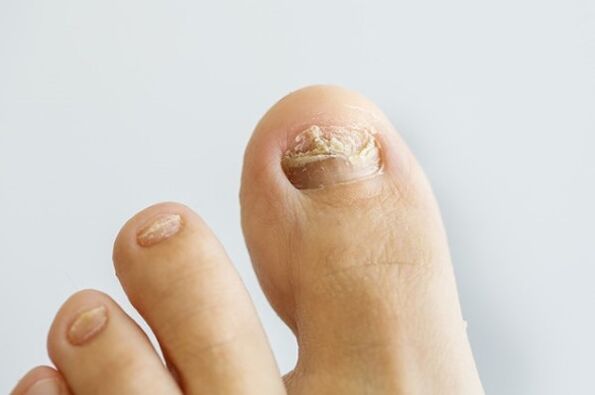
Causes of fungal nail damage
Fungal damage to legs on medical practice are much more common than similar disease in the hands.This is due to the fact that the lower limbs are much more often in contact with the contaminated environment.In this case, the main cause of the occurrence is reduced immunity.The weakened organization is not able to fully resist an infectious agent.This is particularly true for baths, saunas and swimming pools, showers in gymnasiums or in production, hospital services in a hospital.In the first two cases, the risk of infection is high due to the presence of these places by people with fungal infection.In addition, mushrooms are increasing more actively in a wet environment.Hospitals, despite compliance with health standards, constitute a place of concentration of various infections, including fungals.Having become barefoot on the ground in one of these places, the probability of obtaining an infection increases ten times.
In the absence of regular cleaning using aggressive chemistry, its own bath also becomes a sowing of fungal infection.Even if none of the servants were sick with onychomycosis, conditionally pathogenic fungi that live on human skin multiply in the unpleasant bath.An increase in their population has deplorable consequences.
- The wearing of old or other shoes, conditional pathogenic fungi, is on the skin, their incoming shoes (especially the closed type) are inevitable.Microorganisms accumulate in layers of fabric, which also increases the risk of infection.
- Le port de chaussures anciennes ou autres, les champignons pathogènes conditionnels, est sur la peau, leurs chaussures entrant (en particulier le type fermé) sont inévitables. Les micro-organismes s'accumulent dans des couches de tissu, ce qui augmente également le risque d'infection.
- Wearing shoes is not seasoned - one of the infection factors is excessive legs sweat.If a person works in shoes closed in summer or has hot shoes in the room, the probability of fungal damage increases.However, the periodic nail cutting and the reckless washing of the legs with soap may not be enough.It is important to regularly cut the nails, cut the burrs and push the cuticles, use special lotions and constantly clean the keratinized layers of the skin.
- Wounds - we are talking about damage to the plate on the fingers with traits, bruises, cuts.In such cases, blood circulation is disturbed in the damaged area, the nail does not receive the right amount of nutrients.This can cause the development of the fungus.
- Types of fungi and characteristics of the nails on the legs
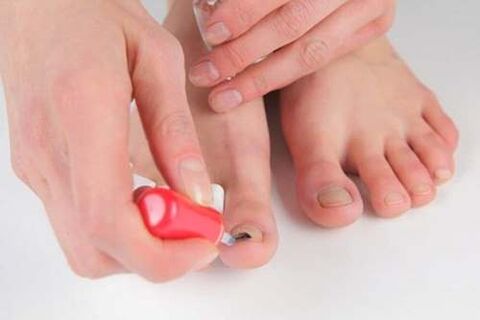
The characteristics of the treatment depend on the identification of the species of fungi that affect the nail plate.This is due to the possibility of selecting drugs that show an activity compared to a particular type of pathogen and the implementation of the most effective treatment.
Dermatophytes
The most common pathogen.According to statistics, dermatophytes cause a fungus on the nails of around 75 to 80% of cases.It is in this case that the state of the immune system occupies the main role in the occurrence of onychomycosis.With normal immunity, fungal damage to dermatophytes are almost impossible.
The infection comes from people or animals that are carrying, as well as in contact with the soil.Ceratinocytes, cellular structures of the epidermis, whose high content is observed in the nails is a favorite nutrition environment of this type of fungus.
Two main subspecies are distinguished in the caste of dermatophytes, most often aschomycosis pathogens:
- red trichophyte (rubrum) - The beginning of the pathological process occurs in the (external or free) part of the nail, hence the infection is gradually moving to the root of the nail plate.In most cases, it is this subspecies that affects the toes.It is characterized by simultaneous damage to nails on several fingers (often standing nearby).The characteristic signs of the infection are the thickening of the affected area of the nail and its darlage.The skin under the outer facet of the dry nail plate and is derogated.The favorite habitat of the subspecies is wet, it is often in the baths, the baths, the swimming pools.The causal agent more often affects the thumbs of the lower limbs, after which he "captures" other nails.A characteristic is considered as focial damage to the nail plate with the appearance of white spots or separate strips.In the future, whitish areas are developing, merging together.When fungal life forms are distributed to other fingers, the dried and peeled skin areas between the fingers are found.
- Yeast
Another pathogen of fungal damage to the legs on the legs is conditionally the pathogenic mushrooms of the Candida family.They are considered conventionally and pathogenic due to the fact that they live constantly on the surface of human skin.In other words, for infection, contact with an infected person, an animal or an external environment does not need at all.In this case, the main trigger for pathology is a significant decrease in immunity, immunodeficiency.
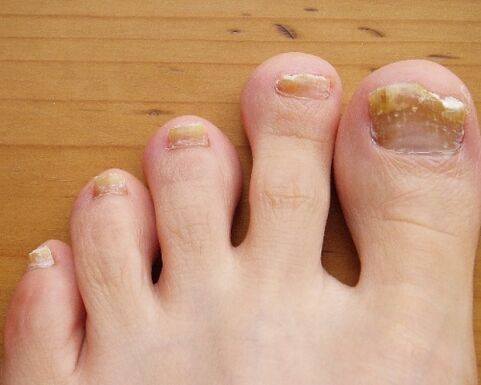
Unlike dermatophytes, yeast mushrooms do not form a layer of mycelium, that is to say that the destruction of the nail plate with this form of damage occurs much less often.But the same factor makes infectious lesions heavier, because the beginning of the pathological process takes the root (proximal) side of the nail.Such varieties of mycosis are considered more serious, but at the same time rare.
The first characteristic of the pathological process caused by yeast mushrooms is detachment from the upper layer of the nail plate.For this reason, the nail loses its brilliance, becomes dull and rough.Damage to nails with yeast mushrooms occur in approximately 7 to 10% of cases.
Musles
The most insidious type of mushrooms, because these life forms are almost everywhere (but especially in a wet environment).Fungal damage to the nail on the leg can cause approximately 35 to 40 subspecies of molds.
Despite the prevalence of the environment, this form of onychomycosis is rarely diagnosed.Therefore, in part, as well as because of an atypical clinical picture, mold is more difficult to diagnose and treat.Another reason for the complexity of the onychomycosis diagnosis of mold is the capacity of mold mushrooms to form mycelium, which makes clinical image a support with damage to dermatophytes.fungal with nail plates are progressing slowly.At the initial steps, the fungus can remain unnoticed at all.But there are still symptoms of the early stages of the development of pathology, which are important to be careful:
Image clinique
La plupart des types de dommages fongiques aux plaques d'ongle progressent lentement. Aux étapes initiales, le champignon peut rester inaperçu du tout. Mais il y a encore des symptômes des premiers stades du développement de la pathologie, qui sont importants pour faire attention:
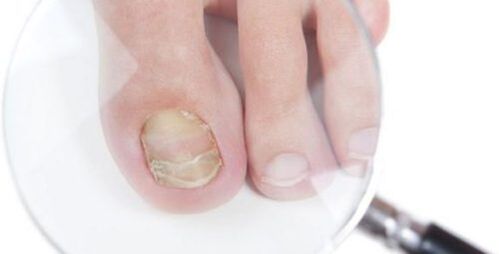
- Violation of growth is the first most negligent sign.In a state of standard, the nail on the leg does not grow more than 2 mm per week.The nail plate, affected by the fungus slows down the growth rate.
- Change the color - first, the nails affected by the fungus fade, losing shine, becoming mat.He also notes that the appearance of the white or yellow interspersed on the surface of the nail or a complete change in the color of the nail plate (white, yellow or shades of brown is possible).Changing the color of the fungus of the nail on the photo above.
- The formation of burrs and the damage to the cuticle is another indirect attribute which indicates the lesion of the fungus of the neighboring skin.If the burrs have started to appear more often and the cuticle area is systematically inflamed or damaged, it is worth checking a fungal lesion.
- Thickening or thinning of the nail plate - variations depend on damage to the specific types of mushrooms.The clinical signs of the subsequent stages of onychomycosis include:
Change the surface of the nail plate - it becomes rough and unequal, dotted with tubers and waves.Also on the nail, similarities of crumbs may appear, which indicates a progressive detachment of the upper layer of the nail.
- In the still subsequent stages, the nail is gradually starting to collapse.Initially, this is expressed in the stratification of the nail plate, the appearance of cracks over the entire surface or the chips on the outside.This is what this mushroom functionality looks like on the leg nails on the photo.
- In the future, destruction is even more serious.The nail will literally collapse, not have time to grow.At the same time, the sections of sub-leg of the dermis are exposed, and the remaining parts of the nail seem clearly painful and unattractive.Consequently, there is a risk of complete destruction or detachment of the nail plate.Severe lesion with a nail fungus on the photo above.
The danger of complications
Many unpleasant sensations and the deterioration of the appearance of the legs of the legs are only the top of the iceberg.The absence of a timely treatment threatens the development of complications, among which the most common are taken into account:
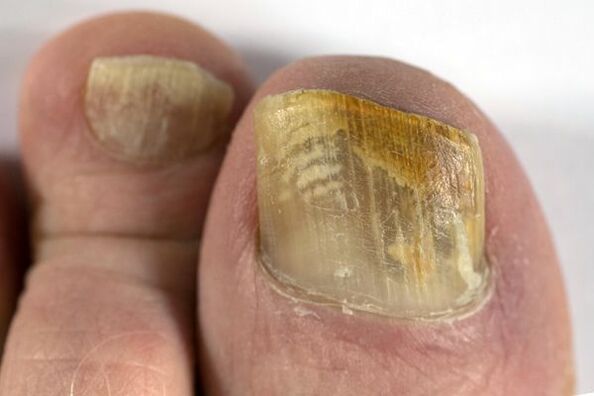
- allergic reactions - at certain stages of development, the fungus of the legs can be perceived by the body as an allergen.
- Fungal damage can weaken the immune system of the body, cause the development or progression of a certain number of diseases, including systemic diseases.Onychomycosis allows you to reach other infections in affected areas.Consequently, the inflammatory and purulent processes develop.
- The particularly serious cases, subject to prolonged evolution and the progression of the disease, can lead to the development of fungal yeast infections.In this case, fungal life forms can penetrate blood and will be spaced throughout the body.
- Treatment methods
For the maximum efficiency of the treatment of nail mushrooms on the legs, complex therapy is often used.At the same time, it is previously important to carry out diagnoses by sowing a bacterial environment to determine the type of pathogen and to choose the most effective drugs.An integrated approach involves the combination of several types of therapy, but sometimes that is not enough.
Pharmacotherapy is the basis of the treatment of most pathologies, including fungal nail lesions.As part of the treatment, two main groups of drugs are used, depending on the stage of development of the pathological process:
La pharmacothérapie est la base du traitement de la plupart des pathologies, y compris des lésions fongiques des ongles. Dans le cadre du traitement, deux principaux groupes de médicaments sont utilisés, selon le stade de développement du processus pathologique:
- Type of local action - These include ointments, gels, varnishes, creams, sprays and lotions with antifungal activity.The method, multiplicity and duration of the use of these drugs are determined by a doctor, but in most cases, they are used at least 2 to 3 weeks.For the most part, these are tablets which, after having sucking gastrointestinal tract, penetrate into the blood and inhibit fungal life forms and also does not allow mycosis to spread.The use of systems is important not only to improve the therapeutic effect, but also in order to prevent relapses.
- Folk remedies
Traditional medicine is considered an auxiliary method to fight against the fungus on the legs.Popular recipes can improve the antifungal effect.The most effective of them are taken into account:
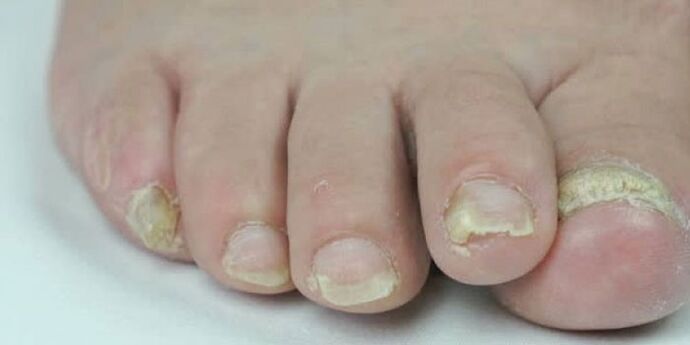
iodine - is capable of dissolving protein structures, which are the basis of fungal life forms.For daily treatment, apply a few drops of iodine to the affected areas with a cotton.
- Peroxide is an effective antibacterial agent that has an disinfectant effect.To improve the effect, peroxide is mixed in equal proportions with vinegar.Then the patient is lubricated with a mixture, it is not necessary to rinse it.The procedure is repeated daily for 1 to 2 weeks.
- Célinin - The best method of using this plant for the treatment of fungi on legs is the poultices.To do this, take a tablespoon of crushed raw materials (leaves and twigs), pour 0.5 liters of water and bring to a boil.The decoction is defended in 15-20 minutes, after which the legs are plunged there for an additional 20-25 minutes.Repeat the procedure daily before bedtime for 2-3 weeks.
Remove the nail
Today in medical practice, mainly the chemical method to eliminate nail plate - Avulces are used.For this, special aggressive drugs are used, the procedure is carried out by a doctor so as not to harm healthy areas of the nail plate and the skin.This method is painless and effective, and the indications for its use are the absence of the results of a conservative treatment or advanced cases of onychomycosis.
Laser therapy
The procedure implies a partial or complete withdrawal of the nail plate.The choice of method depends on the depth of the depth that the fungus has penetrated the nail structure.During laser therapy, an intensive laser irradiation method is used.A special device is removed with nail mushroom layers, after which an antifungal therapy course follows.In this case, after removal, a bandage is applied to the bare areas of the skin, under which an ointment or a cream with an antifungal effect can be placed.The elimination of the nail plate requires regular visits to the doctor in order to make dressings and monitor the growth of the new nail plaque.

Laser treatment of the nails mushrooms on the legs, during which only a few layers of the nail are removed, is carried out in stages, in 7 to 10 procedures (about 10 to 15 minutes are necessary to treat each nail).If the withdrawal is shown, the procedure disappears and takes about 20 minutes, the patient does not feel pain.

















